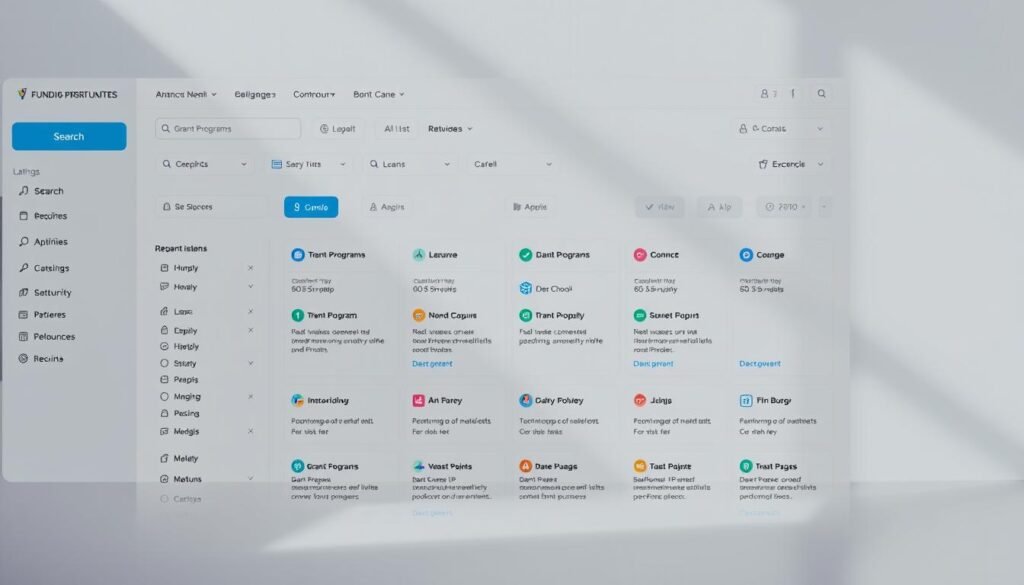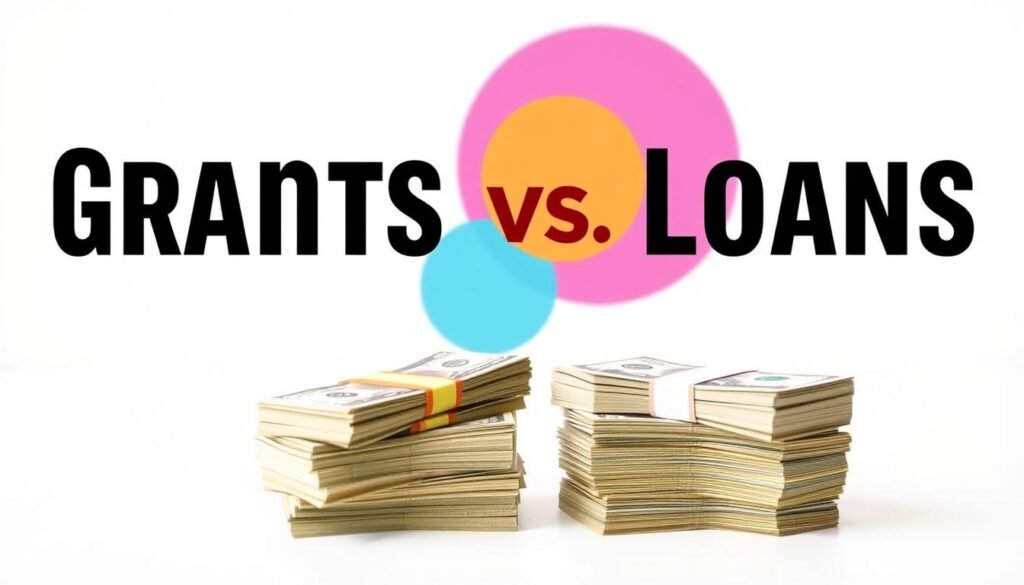Did you know that millions in funding go unclaimed each year simply because small businesses don’t know where to look? Whether you’re launching a startup or expanding an existing venture, securing financial support can be a game-changer. But with so many options available, how do you find the right fit?
The U.S. Chamber’s CO— initiative updates its list of 50+ grant programs weekly, ensuring you have access to the latest opportunities. From Illinois’ $45B infrastructure plan—which includes $3B in capital funding—to private initiatives like Comcast RISE, there’s no shortage of resources. The key is matching your needs to the right program.
Key Takeaways
- Over 50 grant programs are updated weekly by CO—.
- Illinois offers $3B in capital funding as part of a larger infrastructure plan.
- Government and private funding options cater to different needs.
- Aligning grants with your industry and growth stage boosts success.
- Time-sensitive programs, like Comcast RISE, have strict deadlines.
Introduction to Business Grants
Unlike loans, grants provide financial support without repayment obligations. These funds are ideal for startups or expansions, offering a debt-free path to growth.
Federal programs prioritize underrepresented groups. For example, 3% of contracts go to veteran-owned ventures, while 5% target women-owned enterprises.
Compliance is key. Recipients often need to submit progress reports or undergo audits. The San Francisco Accessibility Grant proves it’s worth the effort—approved applications get funds in just 15 days.
For a full list of opportunities, check Grants.gov. Its database includes over 40,000 active funding programs across industries.
Government Grants for Small Businesses
Federal funding opportunities can transform small ventures with zero repayment strings attached. These programs target everything from tech innovation to rural infrastructure, offering tailored solutions for growth.
Grants.gov: Your Starting Point
With 26 federal agencies listed, Grants.gov is the largest database for government grants. Over 40,000 active opportunities are searchable by industry, location, or project type.
New listings update daily, so bookmarking the portal ensures you never miss deadlines. The platform also provides application checklists to streamline submissions.
Community Development Financial Institutions (CDFI) Fund
This program allocates $500M+ annually to boost economic development in low-income areas. Funds support affordable housing, local startups, and job creation.
Eligibility hinges on serving underserved communities. The Texas Enterprise Fund, a CDFI success story, generated 75,000+ jobs.
Small Business Technology Transfer Program (STTR)
STTR bridges small business technology and academic research. Applicants must partner with universities or labs to qualify.
Priority goes to projects with commercialization potential. Past winners include clean energy prototypes and AI-driven healthcare tools.
U.S. Department of Agriculture Rural Development Programs
USDA’s 2025 focus includes rural broadband and agricultural tech. Deadlines vary, but all projects must benefit rural economic development.
Recent funding helped farms adopt automation and villages expand high-speed internet access.
State and Local Business Grants
Local funding programs offer tailored solutions for ventures at every stage. These state business incentives often target specific needs, from infrastructure to workforce development, making them ideal for hyper-local growth.

Illinois Infrastructure Grants
Illinois dedicates $3B to capital projects through its DCEO program. Funds prioritize community upgrades like roads, broadband, and renewable energy installations.
Eligibility hinges on job creation and long-term operations sustainability. Approved projects must align with the state’s 2025 economic plan.
Minnesota Emerging Entrepreneur Loan Program (ELP)
The ELP supports minority and veteran-owned ventures with under 100 employees. Loans at 7.5% interest help cover location-specific costs like equipment or leases.
Recipients also gain mentorship, reinforcing community ties and fostering scalable models.
San Francisco Accessibility Grant
This $10k grant requires CASp inspections and ADA compliance. It’s designed to remove barriers in operations for ventures serving disabled populations.
Fast-track approvals take just 15 days, emphasizing SF’s commitment to inclusive community spaces.
Pro Tip: Pair grants like Texas’ performance-based Enterprise Fund with the Work Opportunity Tax Credit. You could earn up to $9,600 per qualified hire.
Private and Corporate Business Grants
Corporate funding programs offer unique advantages beyond traditional financing. These initiatives often bundle cash awards with services like marketing or mentorship, creating a holistic growth package.
Comcast RISE Grant
Comcast RISE supports 500+ underrepresented business owners annually. Winners receive $5,000 in cash plus technology and advertising packages.
Eligibility focuses on minority- and women-led ventures. The program prioritizes businesses in operation for 1–3 years.
Faire Small Business Grant
New retailers gain a $5,000 inventory credit through Faire’s program. This helps offset upfront costs for product sourcing and store setups.
Applicants must demonstrate a clear plan for scaling operations. The grant is ideal for boutique owners and niche brands.
ZenBusiness $5K Grant Program
ZenBusiness awards $5,000 to startups aged 3–6 months. Recipients also get compliance tools and business owners coaching.
Exclusive to ZenBusiness customers, this grant emphasizes sustainable operations from day one.
Bonus Options: Patagonia funds eco-friendly ventures ($5k–$20k), while FedEx’s annual contest awards $50k for innovative services.
Industry-Specific Business Grants
Specialized funding programs target unique needs across different sectors. Whether you’re reviving a historic diner or developing cutting-edge biotech, tailored financial support exists. These industry grants often come with added resources like mentorship or technical assistance.
2025 Backing Historic Small Restaurants
The 2025 Restaurant Fund awards $50,000 to 50 iconic eateries nationwide. Public nominations help identify candidates preserving culinary heritage. Funds can cover renovations, staff training, or marketing to boost community access.
U.S. National Institutes of Health (NIH) Grants
NIH allocates $500M+ annually for biomedical research. Its SBIR program funds projects with commercialization potential, like AI diagnostics or vaccine tech. Academic partnerships are mandatory, ensuring rigorous development.
Patagonia Corporate Grants Program
Patagonia’s invitation-only program supports eco-friendly projects. Grants range from $5,000–$20,000 for ventures reducing environmental impact. The foundation prioritizes scalable solutions in agriculture and renewable energy.
Pro Tip: USDA’s Value-Added Producer Grants require a 20% match but fund farm-to-table projects. Pair with EDA’s Build to Scale program for tech commercialization (max $5M).
Diversity-Focused Business Grants
Underrepresented founders often face unique challenges, but specialized financial support exists to bridge gaps. These diversity grants prioritize equitable growth for minority-owned ventures, women-led startups, and veteran entrepreneurs.

U.S. Department of Commerce Minority Business Development Agency (MBDA)
MBDA’s 40+ centers nationwide manage a $100M+ annual funding pool. The 8(a) Program offers a 9-year certification, boosting community impact through contracts and technical training.
Women-Owned Small Business Federal Contracting Program
To qualify, ventures must demonstrate 51% female ownership. The program reserves 5% of federal contracts for women-led enterprises, focusing on industries like manufacturing and tech.
Service-Disabled Veteran-Owned Small Business Program
VA verification ensures legitimacy, while HUBZone requirements mandate 35% employee residency in underserved areas. These organizations gain preferential bidding status for government projects.
The Accion Opportunity Fund complements grants with loans up to $250k, enhancing access for marginalized founders. Pairing these resources accelerates long-term success.
Grants for Startups and Early-Stage Businesses
Launching a startup? Early-stage ventures can tap into specialized funding programs designed to fuel rapid growth. These initiatives target high-potential entrepreneurs, offering cash, mentorship, and access to networks.
500 Global Flagship Accelerator
This Silicon Valley program invests $150,000 for 6% equity. Selected startups join a 4-month bootcamp with hands-on training.
Focus areas include scalable technology and market-fit validation. Alumni include Credit Karma and Canva.
Visa Everywhere Initiative
Fintech entrepreneurs compete for $100,000 prizes. Projects must integrate Visa’s APIs to qualify.
Past winners leveraged blockchain and AI to streamline payments. Submissions open quarterly.
Build to Scale (B2S) Program
The Economic Development Administration (EDA) awards up to $5 million for regional tech hubs. Funds support infrastructure and workforce training.
Eligible startups must demonstrate job creation potential. Priority goes to clean energy and biotech ventures.
Bonus Opportunities:
– Challenge.gov lists 200+ active competitions for entrepreneurs.
– The Amber Grant has funded women founders for 25+ years ($10k monthly awards).
Emergency and Disaster Relief Grants
Unexpected crises don’t have to derail your operations—specialized aid exists. These emergency grants offer fast support to stabilize ventures after disasters like floods, fires, or economic downturns.
Small Business Readiness for Resiliency (R4R) Program
The R4R Program provides $5,000 in immediate aid. To qualify, applicants must complete a 4-step preparedness plan, including risk assessments and continuity strategies.
Funds prioritize community-based ventures with under 50 employees. Approved uses include equipment repairs and payroll coverage.
Etsy Emergency Relief Fund
Etsy offers $2,000 to sellers in FEMA-declared disaster zones. Eligible shops must prove 12+ months of activity and revenue loss.
Applications open within 30 days of disaster declarations. This support helps artisans rebuild inventories and online stores.
Restaurant Disaster Relief Fund
DoorDash’s program awards up to $10,000 per restaurant. Chains with 3 or fewer locations qualify, with funds covering rent, utilities, or staff wages.
Recipients also gain free marketing on DoorDash’s platform for 6 months.
Additional Options:
- SBA Disaster Loans: Low 3.75% interest rates for long-term recovery.
- NYFA Emergency Grants: $5,000 for artists facing medical or natural crises.
How to Find Business Grants
Navigating the world of financial support can feel overwhelming, but the right tools make it simple. Start by identifying funding opportunities that match your industry, size, and goals. Databases like Grants.gov filter listings by NAICS codes, narrowing 40,000+ options to relevant matches.

Use geographic filters to find location-specific programs. The SBA Local Assistance Finder pinpoints nearby resources, while MBDA Business Centers guide minority-owned ventures. Always verify eligibility—some grants target rural areas or urban hubs.
Watch for red flags like upfront fees or guaranteed approval claims. Legitimate organizations never charge to apply. Subscription services like Foundation Directory Online offer curated lists but vet them through third-party reviews.
State portals, like California’s Grants Portal, streamline access to regional programs. Pair these with federal databases for full coverage. Pro Tip: Bookmark Grants.gov’s “Weeks in Review” page for deadline alerts.
Eligibility Criteria for Business Grants
Understanding eligibility is the first step to securing financial support. Most programs share core requirements, but specifics vary by funding source and industry.
Over 80% of applications need a DUNS number, while 70% require three years of financial records. Prepare business licenses, tax returns, and bank statements to streamline the process.
Certifications like MBE (Minority Business Enterprise) or WBE (Women’s Business Enterprise) unlock specialized funds. The Davis-Bacon Act mandates wage standards for construction-related awards.
The STTR program exemplifies niche rules—40% of research must come from accredited institutions. For foundation grants, IRS Form 990 analysis reveals alignment with donor priorities.
Proof of operations is vital. Some grants require physical locations or minimum revenue thresholds. Always cross-check criteria before applying to avoid wasted effort.
How to Apply for Business Grants
Securing financial backing starts with a well-prepared application. While each program has unique requirements, most follow a similar three-step process. Proper planning can significantly boost your approval odds—NIH reports a 30% acceptance rate with 90-day reviews.
Step 1: Prepare Your Documentation
Gather essential records before starting. You’ll typically need an EIN, SAM.gov registration, and three years of financial statements. Some programs require narrative essays detailing your growth plans.
Create a master folder with these items:
- Tax returns and bank statements
- Business licenses and certifications
- Project budgets with measurable outcomes
Step 2: Craft a Compelling Application
Use SMART goals (Specific, Measurable, Achievable, Relevant, Time-bound) when describing your project. Clearly explain how the support will create impact. Professional services like grant writers ($150/hour average) can refine your pitch.
Highlight these elements:
- Community benefits beyond revenue
- Your team’s qualifications
- Detailed use of funds
Step 3: Submit and Follow Up
Use Grants.gov Workspace for federal submissions. State portals often have their own systems. Mark deadlines on your calendar—late entries get rejected automatically.
If denied, file FOIA requests to understand why. Many successful applicants reapply with improved materials. Track all correspondence for future reference.
Business Grants vs. Business Loans
Financial backing comes in many forms, each with unique pros and cons. Grants and loans serve different needs, and understanding their differences ensures you pick the right funding path.

Grants require no repayment, while loans must be paid back with interest. Most grants cap at $50,000, but SBA 7(a) loans reach $5 million. Loans often need collateral, whereas grants prioritize growth potential.
Timelines vary too. Grants take months to approve, but loans fund faster—sometimes in weeks. Remember, grants count as taxable income, unlike loan proceeds.
Hybrid Options:
The CAII loan program blends both worlds, offering 25% as a grant. This reduces debt while supporting operations expansion.
Case Study:
A farm combined a $100k USDA grant with a $500k loan to upgrade equipment. The grant covered research, while the loan financed bulk purchases.
For side-by-side comparisons, use the SBA Loan Comparison Chart. It breaks down terms, rates, and eligibility for each funding type.
Common Mistakes to Avoid When Applying
Avoiding simple errors can make or break your funding success. Over 65% of rejections stem from incomplete budgets, while 40% fail due to formatting issues. Knowing these pitfalls upfront saves time and boosts approval odds.
Top application errors include missing deadlines or ignoring matching requirements. For example, a restaurant lost $20k in funds by skipping health permits. Always cross-check submission guidelines.
Budget missteps are costly. OMB Uniform Guidance bars certain expenses, like luxury items. Allocate funds precisely—vague line items trigger rejections. Use templates from the program’s website for accuracy.
Compliance matters. The Davis-Bacon Act mandates fair wages for construction programs. Similarly, research-focused awards may require institutional review board approvals. Overlooking these details derails approvals.
Prepare for audits. Keep records for three years, including receipts and progress reports. A Nevada startup faced clawbacks after failing to document application claims. Stay organized from day one.
Resources for Small Business Owners
Entrepreneurs often overlook valuable support systems designed to accelerate growth. From free consulting to loan programs, these resources provide more than funding—they offer strategic advantages.
Small Business Development Centers (SBDCs)
With 900+ locations nationwide, SBDCs deliver free services to entrepreneurs. Their experts help with business plans, financial projections, and funding searches.
Most centers partner with local universities. This gives access to market research tools and student talent pools. Many also host pitch competitions with cash prizes.
State Business Incentives Database
Over 2,500 programs are tracked in regional databases. The Texas Enterprise Fund, for example, lists tax credits for job creation and equipment purchases.
These resources often include eligibility checkers. Filter by industry, location, or project type to find matches quickly.
SBA-Backed Loans
Three main options exist for business financing:
- 504 loans: Fixed-rate for real estate (up to $5M)
- 7(a) loans: Flexible use funds ($50k–$5M)
- Microloans: $50k max for startups
Each program includes support like lender matching and credit counseling.
Bonus Resources:
SCORE’s 10,000+ mentors provide free advice. Export.gov’s STEP services help navigate international trade. Both expand your access to growth opportunities.
Conclusion
With over $7B in projected funding available by 2025, opportunities for growth are expanding. AI-focused programs and climate resilience initiatives lead emerging trends, offering tailored support for entrepreneurs.
Before applying, review these essentials:
- Verify eligibility criteria
- Prepare financial documents
- Align projects with grant goals
“Financial backing fueled 40% of our expansion,” shares a Patagonia grant recipient. Stay ahead by subscribing to CO— for weekly updates on time-sensitive programs, like July 2025 deadlines.
Take action now—your next opportunity awaits.
FAQ
What types of funding are available for entrepreneurs?
Entrepreneurs can access government-backed awards, private-sector initiatives, and industry-specific programs. These include federal funding, state incentives, and corporate-sponsored opportunities.
How do I check if my company qualifies for financial assistance?
Review program guidelines for location, revenue caps, ownership demographics, and project scope. Most opportunities list requirements on their official websites or application portals.
Where can women founders find specialized support?
The Women-Owned Small Business Federal Contracting Program offers exclusive access to government contracts. Private organizations like Amber Grant also provide monthly awards.
What documents are needed for submission?
Typical requirements include tax records, business licenses, financial statements, and project proposals. Some programs may request demographic data or growth projections.
Can startups receive funding before generating revenue?
Yes. Accelerators like 500 Global and federal initiatives such as STTR provide early-stage capital for innovative concepts without revenue requirements.
How long does the approval process take?
Processing times vary from 30 days for corporate programs to 6+ months for federal awards. Always check timelines before applying.
Are there funds for disaster recovery?
Multiple relief programs exist, including the SBA’s R4R Program and industry-specific options like the Restaurant Disaster Relief Fund.
What’s the difference between awards and traditional loans?
Unlike loans, most financial assistance programs don’t require repayment. However, they often have strict usage guidelines and reporting requirements.



